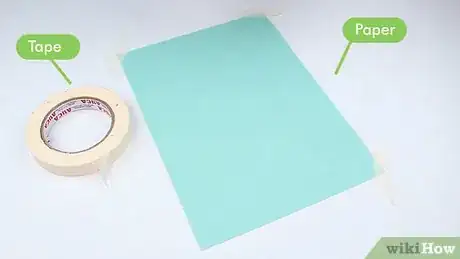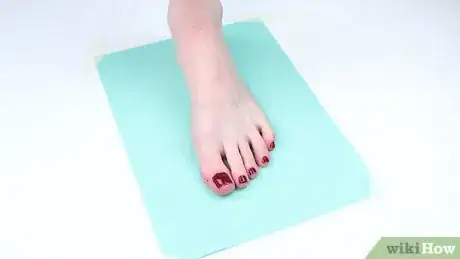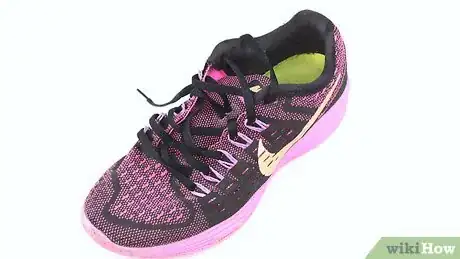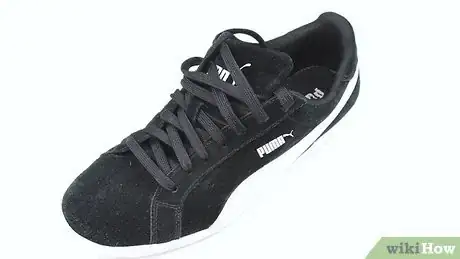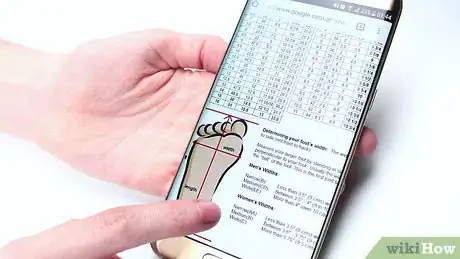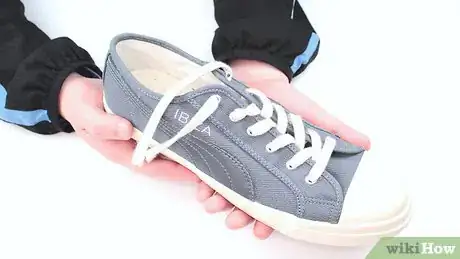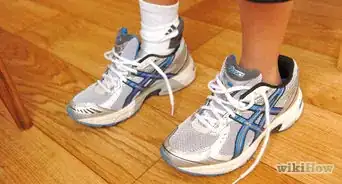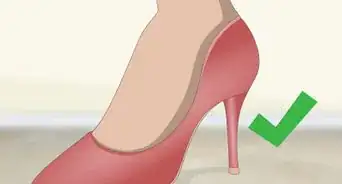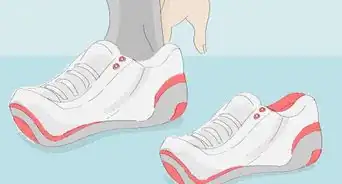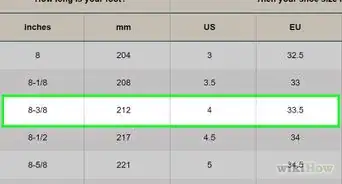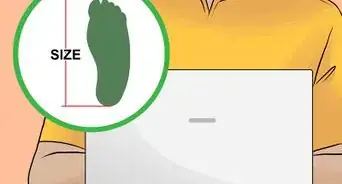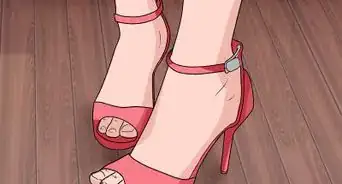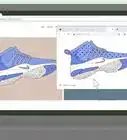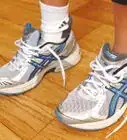wikiHow is a “wiki,” similar to Wikipedia, which means that many of our articles are co-written by multiple authors. To create this article, 34 people, some anonymous, worked to edit and improve it over time.
There are 7 references cited in this article, which can be found at the bottom of the page.
This article has been viewed 2,482,393 times.
Learn more...
At one time or another we've all tried to wear shoes that were too small or too big for us. It's no fun, and you risk potential injury. Knowing your exact shoe size is essential to buying shoes. Finding your shoe size before you shop saves you time in the store and helps you avoid buying a pair that doesn't fit having to return them. Just follow the steps below to find out your shoe size!
Steps
Measure your Foot at Home
-
1Tape a piece of paper down to the floor. You are going to trace an outline of your foot to measure, so avoid doing this on carpet or any other surface that will be difficult to write on.[1]
-
2Place your foot firmly on top of the piece of paper. Your leg should be bent slightly and your shin should be in front of your ankle. Try to put your foot perpendicular to any lines on your paper. You can stand, sit on a chair or crouch down.Advertisement
-
3Draw the outline of your foot all the way around. You can wear the socks you are planning to wear with the shoes you would like to buy, but don't wear shoes.[2]
-
4Mark the length and width of your foot on the paper. Use your marker to draw straight line touching each side of the outline.[3]
-
5Measure the length of your foot. Use a tape measure or ruler to measure from the top to bottom. Write this number down. This number will largely determine your shoe size.[4]
-
6Measure the width of your foot. Measure between the lines on the left and right sides and write the number down. Many shoes come in different widths, so this number will determine which version to buy.
-
7
-
8Use your length and width measurements to find your shoe size on a sizing chart. Men and women use different sizes, as do different countries.[6]
Interpreting the Results
-
1For women, find your length measurement on the chart of US women's sizes below.
- 4 = 8 3/16" or 20.8 centimeter (8.2 in) in length
- 4.5 = 8 5/16" or 21.3 centimeter (8.4 in)
- 5 = 8 11/16" or 21.6 centimeter (8.5 in)
- 5.5 = 8 13/16" or 22.2 centimeter (8.7 in)
- 6 = 9" or 22.5 centimeter (8.9 in)
- 6.5 = 9 3/16" or 23 centimeter (9.1 in)
- 7= 9 5/16" or 23.5 centimeter (9.3 in)
- 7.5 = 9 1/2" or 23.8 centimeter (9.4 in)
- 8 = 9 11/16" or 24.1 centimeter (9.5 in)
- 8.5 = 9 13/16" or 24.6 centimeter (9.7 in)
- 9 = 10" or 25.1 centimeter (9.9 in)
- 9.5 = 10 3/16" or 25.4 centimeter (10.0 in)
- 10 = 10 5/16" or 25.9 centimeter (10.2 in)
- 10.5 = 10 1/2" or 26.2 centimeter (10.3 in)
- 11 = 10 11/16" or 26.7 centimeter (10.5 in)
- 11.5 = 10 13/16" or 27.1 centimeter (10.7 in)
- 12 = 11" or 27.6 centimeter (10.9 in)
-
2For men, find your length measurement on the chart of US men's sizes below.
- 6 = 9 1/4" or 23.8 centimeter (9.4 in) in length
- 6.5 = 9 1/2" or 24.1 centimeter (9.5 in)
- 7 = 9 5/8" or 24.4 centimeter (9.6 in)
- 7.5 = 9 3/4" or 24.8 centimeter (9.8 in)
- 8 = 9 15/16" or 25.4 centimeter (10.0 in)
- 8.5 = 10 1/8" or 25.7 centimeter (10.1 in)
- 9= 10 1/4" or 26 centimeter (10.2 in)
- 9.5 = 10 7/16" or 26.7 centimeter (10.5 in)
- 10 = 10 9/16" or 27 centimeter (10.6 in)
- 10.5 = 10 3/4" or 27.3 centimeter (10.7 in)
- 11 = 10 15/16" or 27.9 centimeter (11.0 in)
- 11.5 = 11 1/8" or 28.3 centimeter (11.1 in)
- 12 = 11 1/4" or 28.6 centimeter (11.3 in)
- 13 = 11 9/16" or 29.4 centimeter (11.6 in)
- 14 = 11 7/8" or 30.2 centimeter (11.9 in)
- 15 = 12 3/16" or 31 centimeter (12.2 in)
- 16 = 12 1/2" or 31.8 centimeter (12.5 in)
-
3Consider your width. Many shoes will also have a width size, ranging through AA, A, B, C, D, E, EE, and EEEE. B is average for women, D is average for men. A and below are narrow, E and up are wide and extra-wide (See chart below).[7]
-
4Consult the manufacturer or shoe store if you have extreme measurements.
| Size | AA | A | B | C | D | E | EE | EEE |
|---|---|---|---|---|---|---|---|---|
| 6 | 2.8/71 | 2.9/74 | 3.1/79 | 3.3/84 | 3.5/89 | 3.7/94 | 3.9/99 | 4.1/104 |
| 6½ | 2.8/71 | 3.0/76 | 3.2/81 | 3.4/86 | 3.6/91 | 3.8/97 | 3.9/99 | 4.1/104 |
| 7 | 2.9/74 | 3.1/79 | 3.3/84 | 3.4/86 | 3.6/91 | 3.8/97 | 4.0/102 | 4.2/107 |
| 7½ | 2.9/74 | 3.1/79 | 3.3/84 | 3.5/89 | 3.7/94 | 3.9/99 | 4.1/104 | 4.3/109 |
| 8 | 3.0/76 | 3.2/81 | 3.4/86 | 3.6/91 | 3.8/97 | 3.9/99 | 4.1/104 | 4.3/109 |
| 8½ | 3.1/79 | 3.3/84 | 3.4/86 | 3.6/91 | 3.8/97 | 4.0/102 | 4.2/107 | 4.4/112 |
| 9 | 3.1/79 | 3.3/84 | 3.5/89 | 3.7/94 | 3.9/99 | 4.1/104 | 4.3/109 | 4.4/112 |
| 9½ | 3.2/81 | 3.4/86 | 3.6/91 | 3.8/97 | 3.9/99 | 4.1/104 | 4.3/109 | 4.5/114 |
| 10 | 3.3/84 | 3.4/86 | 3.6/91 | 3.8/97 | 4.0/102 | 4.2/107 | 4.4/112 | 4.6/117 |
| 10½ | 3.3/84 | 3.5/89 | 3.7/94 | 3.9/99 | 4.1/104 | 4.3/109 | 4.4/112 | 4.6/117 |
| 11 | 3.4/86 | 3.6/91 | 3.8/97 | 3.9/99 | 4.1/104 | 4.3/109 | 4.5/114 | 4.7/119 |
| 11½ | 3.4/86 | 3.6/91 | 3.8/97 | 4.0/102 | 4.2/107 | 4.4/112 | 4.6/117 | 4.8/122 |
| 12 | 3.5/89 | 3.7/94 | 3.9/99 | 4.1/104 | 4.3/109 | 4.4/112 | 4.6/117 | 4.8/122 |
| 12½ | 3.6/91 | 3.8/97 | 3.9/99 | 4.1/104 | 4.3/109 | 4.5/114 | 4.7/119 | 4.9/124 |
| 13 | 3.6/91 | 3.8/97 | 4.0/102 | 4.2/107 | 4.4/112 | 4.6/117 | 4.8/122 | 4.9/124 |
| 13½ | 3.7/94 | 3.9/99 | 4.1/104 | 4.3/109 | 4.4/112 | 4.6/117 | 4.8/122 | 5.0/127 |
Community Q&A
-
QuestionWhat if my length and width give me different shoe sizes?
 Community AnswerThen you may have a narrower or wider than average foot (size D width) and may need to special order online if you can't find a store near you that carries shoes to your specification.
Community AnswerThen you may have a narrower or wider than average foot (size D width) and may need to special order online if you can't find a store near you that carries shoes to your specification. -
QuestionI see a chart for mens' shoe width but not for womens'. Where is the one for women?
 Community AnswerThe article explains that a women's average width is a B and a women's narrow is an A or below, while the men's average is a D. Even though the chart they are using is titled "Men's Shoe Width...", it is actually the same chart for men and for women -- the article just didn't make that clear.
Community AnswerThe article explains that a women's average width is a B and a women's narrow is an A or below, while the men's average is a D. Even though the chart they are using is titled "Men's Shoe Width...", it is actually the same chart for men and for women -- the article just didn't make that clear. -
QuestionIs it okay if my thumb touches in front or shall I go for the next size up?
 Community AnswerYes its okay. After some days they become loose. If its uncomfortable or paining, then only choose the next size.
Community AnswerYes its okay. After some days they become loose. If its uncomfortable or paining, then only choose the next size.
References
- ↑ https://www.liveabout.com/how-to-measure-your-feet-2987812
- ↑ https://www.phc-online.com/v/vspfiles/html/foot_chart_popup.htm
- ↑ https://www.whowhatwear.co.uk/how-to-find-shoe-size/slide4
- ↑ http://www.sedl.org/afterschool/lessonplans/index.cgi?show_record=87
- ↑ http://trendsurvivor.com/are-you-wearing-the-wrong-shoe-size/
- ↑ https://www.shoesizingcharts.com/
- ↑ https://www.asics.com/us/en-us/shoe-width-guide
About This Article
To find your shoe size, start by placing a piece of paper on the floor and tracing the outline of your bare foot onto it. Then, use a ruler to draw a rectangle around the outline that touches the furthest point on each side of your foot. Finally, measure the length and width of the rectangle to get your shoe size. Keep in mind that most shoe sizes are based on the length of your foot, although some will also include the width. If you want to learn the standard shoe sizes associated with the length of your foot, keep reading the article!
